Data Center Construction Market Size 2025-2029
The data center construction market size is valued to increase USD 41 billion, at a CAGR of 8.8% from 2024 to 2029. Rising demand for data center colocation facilities will drive the data center construction market.
Major Market Trends & Insights
- Europe dominated the market and accounted for a 32% growth during the forecast period.
- By Application - Enterprise segment was valued at USD 23.20 billion in 2023
- By Type - Electrical construction segment accounted for the largest market revenue share in 2023
Market Size & Forecast
- Market Opportunities: USD 70.71 billion
- Market Future Opportunities: USD 41.00 billion
- CAGR : 8.8%
- Europe: Largest market in 2023
Market Summary
- The market is a dynamic and continuously evolving sector, driven by the rising demand for colocation facilities and the growing focus on constructing energy-efficient, or "green," data centers. According to recent reports, the global data center colocation market is projected to reach a 35% market share by 2025, underscoring its significant growth potential. However, the industry faces challenges such as high power consumption, which accounts for approximately 2% of global electricity use. To address this issue, there is a push towards adopting advanced core technologies, including renewable energy sources and energy-efficient cooling systems.
- Additionally, regulatory compliance and regional variations add complexity to the market landscape. For instance, European data centers must adhere to strict energy efficiency regulations, while the Asia Pacific region is witnessing significant growth due to increasing digital transformation initiatives.
What will be the Size of the Data Center Construction Market during the forecast period?
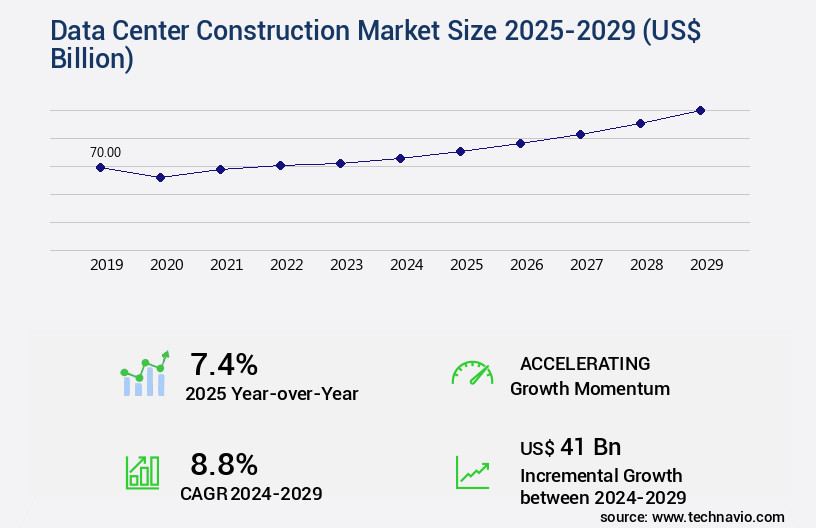
Get Key Insights on Market Forecast (PDF) Request Free Sample
How is the Data Center Construction Market Segmented and what are the key trends of market segmentation?
The data center construction industry research report provides comprehensive data (region-wise segment analysis), with forecasts and estimates in "USD billion" for the period 2025-2029, as well as historical data from 2019-2023 for the following segments.
- Application
- Enterprise
- Cloud
- Colocation
- Hyperscale
- Type
- Electrical construction
- Mechanical construction
- General construction
- Geography
- North America
- Europe
- APAC
- South America
- Rest of World (ROW)
By Application Insights
The enterprise segment is estimated to witness significant growth during the forecast period.
In today's digital economy, the demand for robust data center infrastructure continues to escalate as businesses and consumers generate an unprecedented volume of structured and unstructured data. Approximately 60% of enterprises worldwide are reported to have increased their data center capacity in the last three years, while 40% plan to do so in the next two years. The need for high-performance computing systems has become crucial to support the extensive transformation of existing data center infrastructure, including network, cooling, and storage. Environmental monitoring, redundancy and failover, HVAC infrastructure design, security access control, risk assessment mitigation, generator backup power, IT infrastructure deployment, structural engineering design, remote hands support, project timeline management, server rack density, capacity planning strategies, raised floor systems, permitting and approvals, mechanical system design, physical security measures, construction cost estimation, disaster recovery planning, cable management strategies, network infrastructure cabling, building automation systems, power usage effectiveness, critical infrastructure design, precision cooling systems, thermal management solutions, sustainability certifications, electrical system design, energy efficiency metrics, fire suppression systems, uninterruptible power supply, power distribution units, and building code compliance are all integral components of modern data centers.
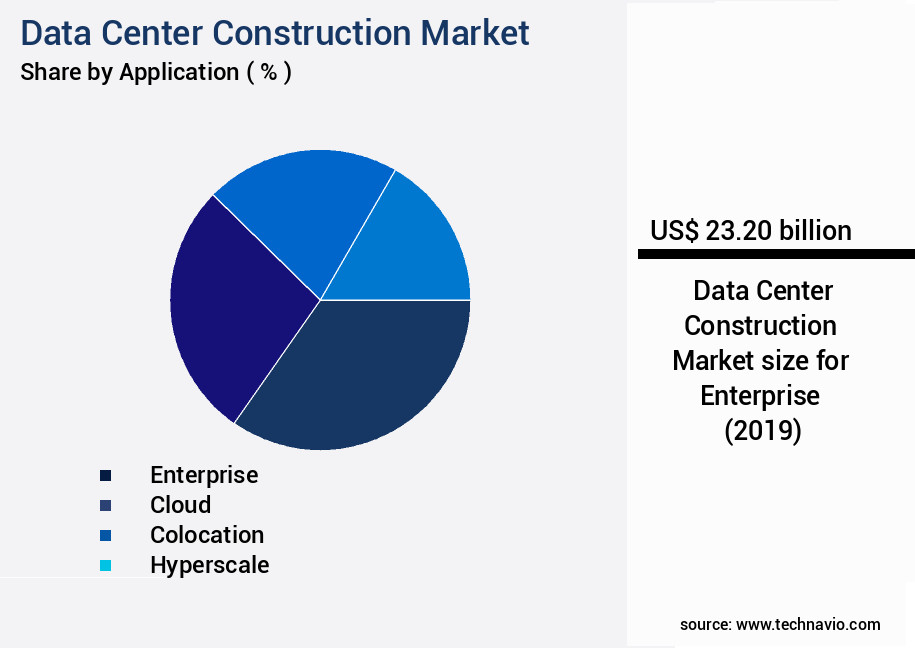
Request Free Sample
The Enterprise segment was valued at USD 23.20 billion in 2019 and showed a gradual increase during the forecast period.
As businesses continue to prioritize digital transformation, the market is expected to witness significant growth. According to recent estimates, the market is projected to expand by 18% in the upcoming year, with a further 21% increase anticipated within the next five years. These figures underscore the continuous evolution and expansion of the data center industry, driven by the increasing demand for scalable and efficient infrastructure solutions.
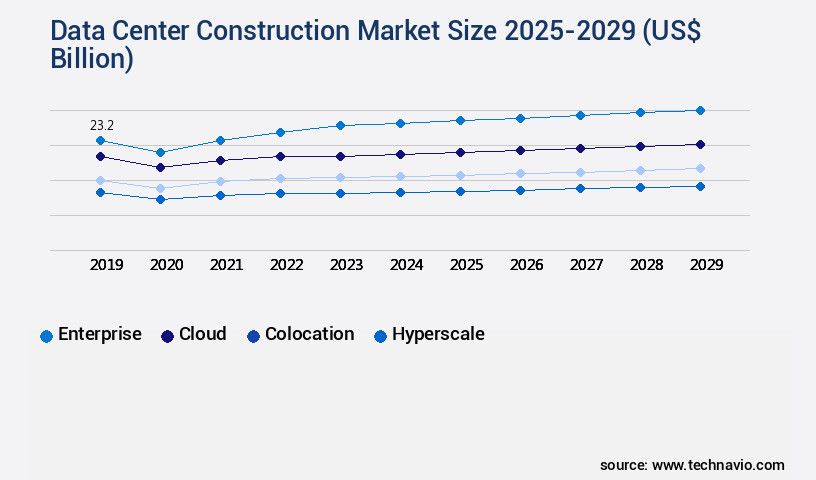
Request Free Sample
Regional Analysis
Europe is estimated to contribute 32% to the growth of the global market during the forecast period. Technavio's analysts have elaborately explained the regional trends and drivers that shape the market during the forecast period.
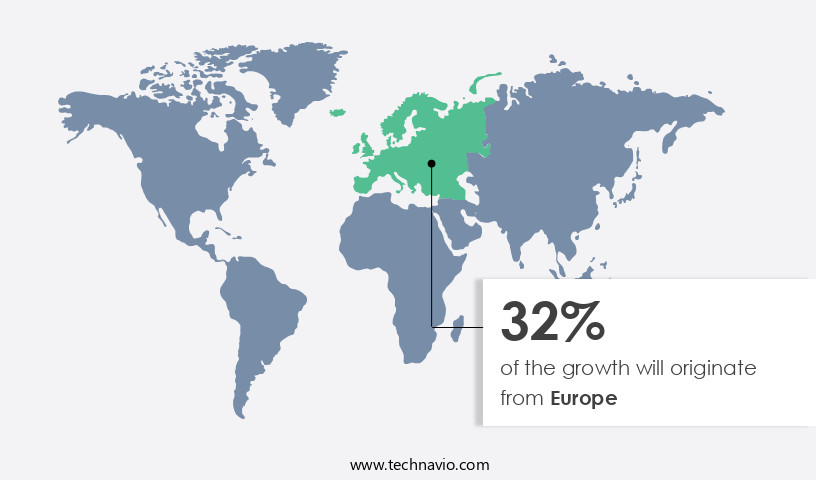
See How Data Center Construction Market Demand is Rising in Europe Request Free Sample
The North American data center market experiences continuous expansion due to escalating consumer and enterprise data traffic. This trend is fueled by several factors, including the proliferation of Internet of Things (IoT) devices and the adoption of autonomous technologies by numerous enterprises. Furthermore, substantial investments are being made in Artificial Intelligence (AI) and autonomous vehicles, which necessitate advanced data processing capabilities. According to recent data, IP traffic in North America is increasing exponentially, driven by data-capable devices and high-bandwidth applications.
This growth necessitates the establishment of more data centers in the region, leading to substantial investments in mechanical components and electrical equipment.
Market Dynamics
Our researchers analyzed the data with 2024 as the base year, along with the key drivers, trends, and challenges. A holistic analysis of drivers will help companies refine their marketing strategies to gain a competitive advantage.
The market is experiencing significant growth, driven by the increasing demand for high-density server room cooling and data center infrastructure management. Modular data center construction is gaining popularity due to its cost-effectiveness, enabling businesses to efficiently scale their operations. In the realm of cooling technologies, geothermal and liquid cooling are increasingly being deployed to enhance energy efficiency and reduce environmental impact. Data center security system design is another critical aspect, with predictive maintenance and building automation system integration becoming essential to minimize downtime and optimize performance. Sustainable data center construction practices, such as efficient space utilization strategies and improved power usage effectiveness metrics, are also gaining traction.
Moreover, cloud-ready data center design principles, edge data center infrastructure design, and AI-powered data center management are becoming increasingly important as businesses seek to improve operational agility and reduce latency. Advanced monitoring systems and fault-tolerant power distribution systems are also being implemented to ensure robustness and reliability. Optimized cable management techniques and comprehensive disaster recovery planning are other key considerations in the market. Adoption rates of advanced technologies, such as AI and predictive maintenance, are significantly higher in large enterprises compared to small and medium-sized businesses, accounting for over 60% of total investments. This underscores the importance of these technologies in driving business growth and maintaining a competitive edge.
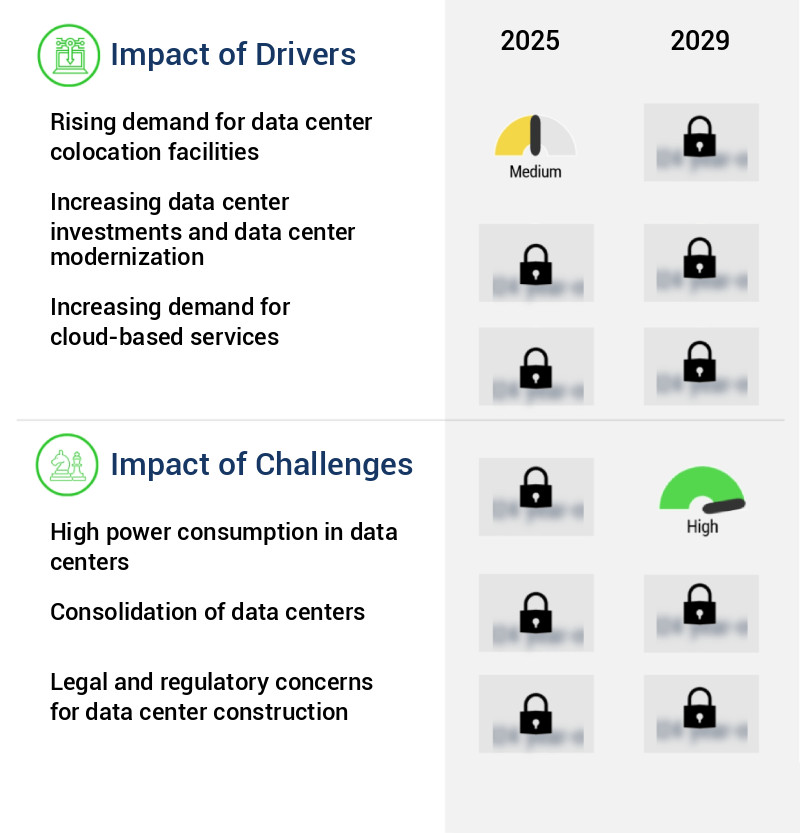
What are the key market drivers leading to the rise in the adoption of Data Center Construction Industry?
- The surge in demand for data center colocation facilities serves as the primary driver for the market's growth.
- Colocation services have gained significant traction among businesses, both small and large, due to the escalating costs associated with managing their own data centers. The construction of tier 3 and tier 4 data centers can cost approximately USD 800 and USD 1,000 per square foot, respectively. This financial burden often deters small and medium enterprises (SMEs) from investing in their own data centers. In response, communication service providers (CSPs) have partnered with data center service providers to offer colocation and managed hosting services. These services enable businesses to rent space in a secure, shared environment to house their hardware, including servers, storage devices, and network equipment.
- By opting for colocation and managed hosting, businesses can significantly reduce their capital expenditures (CAPEX) and operational expenditures (OPEX) while benefiting from the expertise and resources of experienced data center operators. The collaboration between CSPs and data center service providers has become a crucial trend in the evolving data center landscape.
What are the market trends shaping the Data Center Construction Industry?
- The construction of green data centers is gaining increasing importance in the market trend. This emerging trend prioritizes the use of renewable energy sources and sustainable practices in data center operations.
- Green data centers, a significant advancement in the data center industry, prioritize minimizing environmental impact through energy efficiency. These centers employ eco-friendly building materials, fostering sustainable ecosystems via efficient waste recycling. Advanced technologies and strategies include the use of low-emission materials, waste recycling, catalytic converters in backup generators, and alternative energy technologies like photovoltaics, heat pumps, and evaporative cooling. Although the initial investment for green data centers is substantial, the long-term cost savings make it an attractive proposition for enterprises.
- The construction and operation of these centers represent a strategic shift towards sustainable business practices. Green data centers are a crucial response to the evolving market demand for energy efficiency and environmental consciousness.
What challenges does the Data Center Construction Industry face during its growth?
- Data center power consumption, which is a significant challenge and a key factor impeding industry growth, necessitates continuous innovation and optimization to ensure sustainable and efficient operations.
- Data traffic is experiencing exponential growth, driven by the expanding use of social media platforms, the integration of blockchain and automation technologies, and the increasing adoption of AI across various sectors. This trend is leading to significant investments in data center facilities to manage and store vast amounts of data. By 2030, data centers are projected to be the largest global energy consumers.
- The ICT sector is anticipated to account for approximately one-quarter of the world's electricity consumption by that year. Servers and cooling systems are major electricity consumers within data centers. Developing energy-efficient solutions that minimize power consumption and carbon emissions is a significant challenge for companies in this sector.
Exclusive Technavio Analysis on Customer Landscape
The data center construction market forecasting report includes the adoption lifecycle of the market, covering from the innovator's stage to the laggard's stage. It focuses on adoption rates in different regions based on penetration. Furthermore, the data center construction market report also includes key purchase criteria and drivers of price sensitivity to help companies evaluate and develop their market growth analysis strategies.
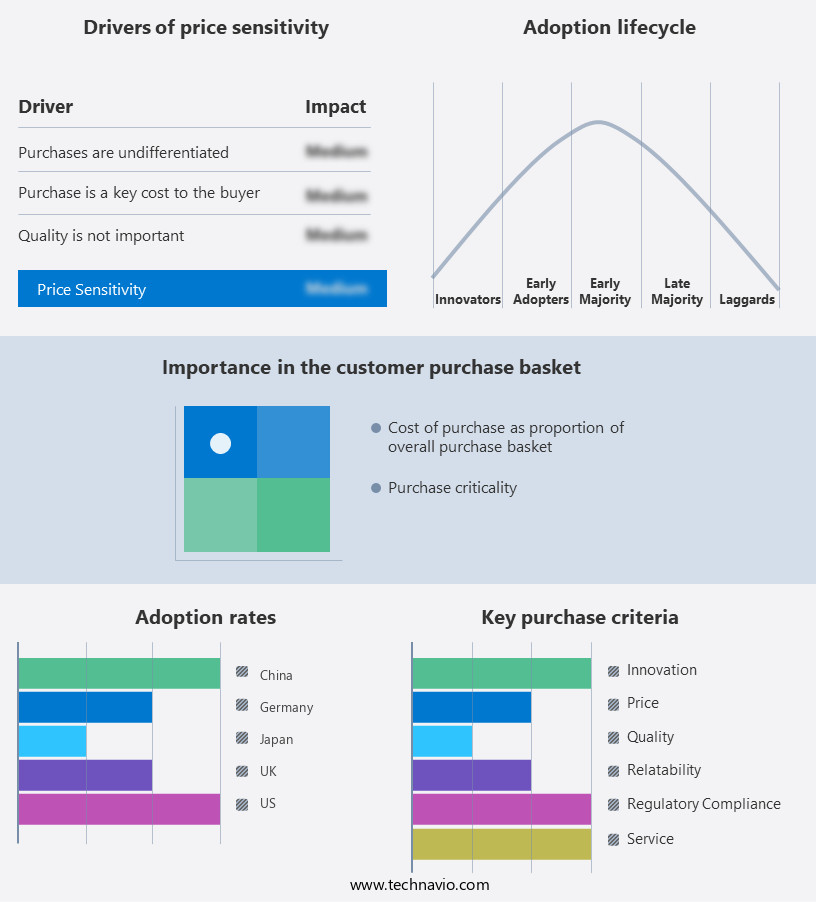
Customer Landscape of Data Center Construction Industry
Competitive Landscape
Companies are implementing various strategies, such as strategic alliances, data center construction market forecast, partnerships, mergers and acquisitions, geographical expansion, and product/service launches, to enhance their presence in the industry.
ABB Ltd. - This company specializes in data center construction, delivering integrated electrical solutions and automation systems to optimize power distribution and management within facilities.
The industry research and growth report includes detailed analyses of the competitive landscape of the market and information about key companies, including:
- ABB Ltd.
- AECOM
- AMETEK Inc.
- Arup Group Ltd.
- Asetek
- Clune Construction Co.
- Delta Electronics Inc.
- DPR Construction
- Eaton Corp. plc
- Emerson Electric Co.
- FORTIS CONSTRUCTION Inc.
- Gilbane Inc.
- HDR Inc.
- Hensel Phelps
- HITT Contracting Inc.
- Iron Mountain Inc.
- J.E. Dunn Construction Co.
- Nippon Telegraph and Telephone Corp.
- SAS Institute Inc.
- Siemens AG
Qualitative and quantitative analysis of companies has been conducted to help clients understand the wider business environment as well as the strengths and weaknesses of key industry players. Data is qualitatively analyzed to categorize companies as pure play, category-focused, industry-focused, and diversified; it is quantitatively analyzed to categorize companies as dominant, leading, strong, tentative, and weak.
Recent Development and News in Data Center Construction Market
- In January 2024, Schneider Electric, a global energy management and automation company, announced the acquisition of APC by Schneider Electric, a leading provider of data center infrastructure solutions. This strategic move aimed to expand Schneider Electric's presence in the data center market and strengthen its product offerings (Schneider Electric Press Release, 2024).
- In March 2024, Amazon Web Services (AWS), a major cloud services provider, unveiled its new custom-designed data center in Ohio, USA, with an investment of over USD 15 billion. This expansion was part of AWS's commitment to reducing carbon emissions and increasing renewable energy usage in its data centers (AWS Press Release, 2024).
- In May 2024, Microsoft and NVIDIA announced a strategic partnership to deliver Microsoft Azure AI services on NVIDIA GPUs. This collaboration aimed to accelerate AI innovation and provide enhanced computing capabilities to Microsoft's cloud customers (Microsoft News Center, 2024).
- In April 2025, Google announced the completion of its new data center campus in Finland, which is powered entirely by renewable energy. This development marked a significant step forward in Google's commitment to carbon-neutral energy usage in its data centers (Google Cloud Blog, 2025).
Dive into Technavio's robust research methodology, blending expert interviews, extensive data synthesis, and validated models for unparalleled Data Center Construction Market insights. See full methodology.
|
Market Scope
|
|
Report Coverage
|
Details
|
|
Page number
|
212
|
|
Base year
|
2024
|
|
Historic period
|
2019-2023 |
|
Forecast period
|
2025-2029
|
|
Growth momentum & CAGR
|
Accelerate at a CAGR of 8.8%
|
|
Market growth 2025-2029
|
USD 41 billion
|
|
Market structure
|
Fragmented
|
|
YoY growth 2024-2025(%)
|
7.4
|
|
Key countries
|
US, China, Germany, UK, Canada, France, Japan, Italy, Brazil, and South Korea
|
|
Competitive landscape
|
Leading Companies, Market Positioning of Companies, Competitive Strategies, and Industry Risks
|
Request Free Sample
Research Analyst Overview
- The market is a dynamic and evolving landscape, marked by continuous innovation and adaptation to meet the ever-growing demand for digital infrastructure. Redundancy and failover systems have become a crucial aspect of data center design, ensuring uninterrupted operations and minimizing downtime. Environmental monitoring systems are increasingly integrated into HVAC infrastructure design to optimize energy efficiency and improve Power Usage Effectiveness (PUE). Security access control and risk assessment mitigation strategies are essential components of critical infrastructure design. Generator backup power and uninterruptible power supply systems ensure business continuity during power outages. IT infrastructure deployment and server rack density capacity planning strategies enable efficient use of space and resources.
- Structural engineering design and permitting and approvals processes are vital for ensuring building code compliance and safety. Mechanical system design and physical security measures are integral to maintaining optimal operating conditions and protecting against unauthorized access. Construction cost estimation and project timeline management are crucial for minimizing expenses and delivering projects on schedule. Remote hands support and network infrastructure cabling are essential for effective maintenance and management of data centers. Building automation systems and precision cooling systems enable efficient thermal management and energy conservation. Sustainability certifications and electrical system design contribute to reducing environmental impact and enhancing corporate social responsibility.
- Fire suppression systems and power distribution units are essential components of disaster recovery planning, ensuring business continuity in the face of unexpected events. Cable management strategies and citation of energy efficiency metrics further optimize data center operations and reduce overall costs. In summary, the market is characterized by ongoing innovation and the integration of advanced technologies to address the evolving needs of businesses and organizations. From redundancy and failover systems to sustainability certifications, each element plays a crucial role in ensuring optimal performance, energy efficiency, and cost-effectiveness.
What are the Key Data Covered in this Data Center Construction Market Research and Growth Report?
-
What is the expected growth of the Data Center Construction Market between 2025 and 2029?
-
What segmentation does the market report cover?
-
The report segmented by Application (Enterprise, Cloud, Colocation, and Hyperscale), Type (Electrical construction, Mechanical construction, and General construction), and Geography (North America, Europe, APAC, South America, and Middle East and Africa)
-
Which regions are analyzed in the report?
-
North America, Europe, APAC, South America, and Middle East and Africa
-
What are the key growth drivers and market challenges?
-
Who are the major players in the Data Center Construction Market?
-
Key Companies ABB Ltd., AECOM, AMETEK Inc., Arup Group Ltd., Asetek, Clune Construction Co., Delta Electronics Inc., DPR Construction, Eaton Corp. plc, Emerson Electric Co., FORTIS CONSTRUCTION Inc., Gilbane Inc., HDR Inc., Hensel Phelps, HITT Contracting Inc., Iron Mountain Inc., J.E. Dunn Construction Co., Nippon Telegraph and Telephone Corp., SAS Institute Inc., and Siemens AG
Market Research Insights
- The market continues to evolve, with a focus on enhancing operational efficiency, reducing energy consumption, and integrating renewable energy. Two notable trends include the implementation of building information modeling in 60% of new projects, enabling more accurate capacity expansion planning and reducing construction waste by up to 20%. Additionally, cooling tower efficiency has improved by 15% through the adoption of green building practices and advanced technologies, contributing to overall energy savings. Quality assurance protocols, cybersecurity implementation, and safety regulations compliance are also prioritized to ensure data center uptime and performance benchmarking.
- Budgetary control processes and lifecycle cost analysis are essential in optimizing resources and minimizing operational expenses. Remote monitoring tools and power capacity planning are integral to maintaining optimal network latency and ensuring physical security standards. Data center certifications, environmental impact assessments, and waste management strategies further enhance the sustainability and efficiency of these critical infrastructure facilities.
We can help! Our analysts can customize this data center construction market research report to meet your requirements.
Get in touch
1 Executive Summary
- 1.1 Market overview
- Executive Summary - Chart on Market Overview
- Executive Summary - Data Table on Market Overview
- Executive Summary - Chart on Global Market Characteristics
- Executive Summary - Chart on Market by Geography
- Executive Summary - Chart on Market Segmentation by Application
- Executive Summary - Chart on Market Segmentation by Type
- Executive Summary - Chart on Incremental Growth
- Executive Summary - Data Table on Incremental Growth
- Executive Summary - Chart on Company Market Positioning
2 Technavio Analysis
- 2.1 Analysis of price sensitivity, lifecycle, customer purchase basket, adoption rates, and purchase criteria
- Analysis of price sensitivity, lifecycle, customer purchase basket, adoption rates, and purchase criteria
- 2.2 Criticality of inputs and Factors of differentiation
- Overview on criticality of inputs and factors of differentiation
- 2.3 Factors of disruption
- Overview on factors of disruption
- 2.4 Impact of drivers and challenges
- Impact of drivers and challenges in 2024 and 2029
3 Market Landscape
- 3.1 Market ecosystem
- Parent Market
- Data Table on - Parent Market
- 3.2 Market characteristics
- Market characteristics analysis
4 Market Sizing
- 4.1 Market definition
- Offerings of companies included in the market definition
- 4.2 Market segment analysis
- 4.4 Market outlook: Forecast for 2024-2029
- Chart on Global - Market size and forecast 2024-2029 ($ billion)
- Data Table on Global - Market size and forecast 2024-2029 ($ billion)
- Chart on Global Market: Year-over-year growth 2024-2029 (%)
- Data Table on Global Market: Year-over-year growth 2024-2029 (%)
5 Historic Market Size
- 5.1 Global Data Center Construction Market 2019 - 2023
- Historic Market Size - Data Table on Global Data Center Construction Market 2019 - 2023 ($ billion)
- 5.2 Application segment analysis 2019 - 2023
- Historic Market Size - Application Segment 2019 - 2023 ($ billion)
- 5.3 Type segment analysis 2019 - 2023
- Historic Market Size - Type Segment 2019 - 2023 ($ billion)
- 5.4 Geography segment analysis 2019 - 2023
- Historic Market Size - Geography Segment 2019 - 2023 ($ billion)
- 5.5 Country segment analysis 2019 - 2023
- Historic Market Size - Country Segment 2019 - 2023 ($ billion)
6 Qualitative Analysis
- 6.1 Impact of AI on Global Data Center Construction Market
7 Five Forces Analysis
- 7.1 Five forces summary
- Five forces analysis - Comparison between 2024 and 2029
- 7.2 Bargaining power of buyers
- Bargaining power of buyers - Impact of key factors 2024 and 2029
- 7.3 Bargaining power of suppliers
- Bargaining power of suppliers - Impact of key factors in 2024 and 2029
- 7.4 Threat of new entrants
- Threat of new entrants - Impact of key factors in 2024 and 2029
- 7.5 Threat of substitutes
- Threat of substitutes - Impact of key factors in 2024 and 2029
- 7.6 Threat of rivalry
- Threat of rivalry - Impact of key factors in 2024 and 2029
- 7.7 Market condition
- Chart on Market condition - Five forces 2024 and 2029
8 Market Segmentation by Application
- 8.1 Market segments
- Chart on Application - Market share 2024-2029 (%)
- Data Table on Application - Market share 2024-2029 (%)
- 8.2 Comparison by Application
- Chart on Comparison by Application
- Data Table on Comparison by Application
- 8.3 Enterprise - Market size and forecast 2024-2029
- Chart on Enterprise - Market size and forecast 2024-2029 ($ billion)
- Data Table on Enterprise - Market size and forecast 2024-2029 ($ billion)
- Chart on Enterprise - Year-over-year growth 2024-2029 (%)
- Data Table on Enterprise - Year-over-year growth 2024-2029 (%)
- 8.4 Cloud - Market size and forecast 2024-2029
- Chart on Cloud - Market size and forecast 2024-2029 ($ billion)
- Data Table on Cloud - Market size and forecast 2024-2029 ($ billion)
- Chart on Cloud - Year-over-year growth 2024-2029 (%)
- Data Table on Cloud - Year-over-year growth 2024-2029 (%)
- 8.5 Colocation - Market size and forecast 2024-2029
- Chart on Colocation - Market size and forecast 2024-2029 ($ billion)
- Data Table on Colocation - Market size and forecast 2024-2029 ($ billion)
- Chart on Colocation - Year-over-year growth 2024-2029 (%)
- Data Table on Colocation - Year-over-year growth 2024-2029 (%)
- 8.6 Hyperscale - Market size and forecast 2024-2029
- Chart on Hyperscale - Market size and forecast 2024-2029 ($ billion)
- Data Table on Hyperscale - Market size and forecast 2024-2029 ($ billion)
- Chart on Hyperscale - Year-over-year growth 2024-2029 (%)
- Data Table on Hyperscale - Year-over-year growth 2024-2029 (%)
- 8.7 Market opportunity by Application
- Market opportunity by Application ($ billion)
- Data Table on Market opportunity by Application ($ billion)
9 Market Segmentation by Type
- 9.1 Market segments
- Chart on Type - Market share 2024-2029 (%)
- Data Table on Type - Market share 2024-2029 (%)
- 9.2 Comparison by Type
- Chart on Comparison by Type
- Data Table on Comparison by Type
- 9.3 Electrical construction - Market size and forecast 2024-2029
- Chart on Electrical construction - Market size and forecast 2024-2029 ($ billion)
- Data Table on Electrical construction - Market size and forecast 2024-2029 ($ billion)
- Chart on Electrical construction - Year-over-year growth 2024-2029 (%)
- Data Table on Electrical construction - Year-over-year growth 2024-2029 (%)
- 9.4 Mechanical construction - Market size and forecast 2024-2029
- Chart on Mechanical construction - Market size and forecast 2024-2029 ($ billion)
- Data Table on Mechanical construction - Market size and forecast 2024-2029 ($ billion)
- Chart on Mechanical construction - Year-over-year growth 2024-2029 (%)
- Data Table on Mechanical construction - Year-over-year growth 2024-2029 (%)
- 9.5 General construction - Market size and forecast 2024-2029
- Chart on General construction - Market size and forecast 2024-2029 ($ billion)
- Data Table on General construction - Market size and forecast 2024-2029 ($ billion)
- Chart on General construction - Year-over-year growth 2024-2029 (%)
- Data Table on General construction - Year-over-year growth 2024-2029 (%)
- 9.6 Market opportunity by Type
- Market opportunity by Type ($ billion)
- Data Table on Market opportunity by Type ($ billion)
10 Customer Landscape
- 10.1 Customer landscape overview
- Analysis of price sensitivity, lifecycle, customer purchase basket, adoption rates, and purchase criteria
11 Geographic Landscape
- 11.1 Geographic segmentation
- Chart on Market share by geography 2024-2029 (%)
- Data Table on Market share by geography 2024-2029 (%)
- 11.2 Geographic comparison
- Chart on Geographic comparison
- Data Table on Geographic comparison
- 11.3 North America - Market size and forecast 2024-2029
- Chart on North America - Market size and forecast 2024-2029 ($ billion)
- Data Table on North America - Market size and forecast 2024-2029 ($ billion)
- Chart on North America - Year-over-year growth 2024-2029 (%)
- Data Table on North America - Year-over-year growth 2024-2029 (%)
- 11.4 Europe - Market size and forecast 2024-2029
- Chart on Europe - Market size and forecast 2024-2029 ($ billion)
- Data Table on Europe - Market size and forecast 2024-2029 ($ billion)
- Chart on Europe - Year-over-year growth 2024-2029 (%)
- Data Table on Europe - Year-over-year growth 2024-2029 (%)
- 11.5 APAC - Market size and forecast 2024-2029
- Chart on APAC - Market size and forecast 2024-2029 ($ billion)
- Data Table on APAC - Market size and forecast 2024-2029 ($ billion)
- Chart on APAC - Year-over-year growth 2024-2029 (%)
- Data Table on APAC - Year-over-year growth 2024-2029 (%)
- 11.6 South America - Market size and forecast 2024-2029
- Chart on South America - Market size and forecast 2024-2029 ($ billion)
- Data Table on South America - Market size and forecast 2024-2029 ($ billion)
- Chart on South America - Year-over-year growth 2024-2029 (%)
- Data Table on South America - Year-over-year growth 2024-2029 (%)
- 11.7 Middle East and Africa - Market size and forecast 2024-2029
- Chart on Middle East and Africa - Market size and forecast 2024-2029 ($ billion)
- Data Table on Middle East and Africa - Market size and forecast 2024-2029 ($ billion)
- Chart on Middle East and Africa - Year-over-year growth 2024-2029 (%)
- Data Table on Middle East and Africa - Year-over-year growth 2024-2029 (%)
- 11.8 US - Market size and forecast 2024-2029
- Chart on US - Market size and forecast 2024-2029 ($ billion)
- Data Table on US - Market size and forecast 2024-2029 ($ billion)
- Chart on US - Year-over-year growth 2024-2029 (%)
- Data Table on US - Year-over-year growth 2024-2029 (%)
- 11.9 China - Market size and forecast 2024-2029
- Chart on China - Market size and forecast 2024-2029 ($ billion)
- Data Table on China - Market size and forecast 2024-2029 ($ billion)
- Chart on China - Year-over-year growth 2024-2029 (%)
- Data Table on China - Year-over-year growth 2024-2029 (%)
- 11.10 Germany - Market size and forecast 2024-2029
- Chart on Germany - Market size and forecast 2024-2029 ($ billion)
- Data Table on Germany - Market size and forecast 2024-2029 ($ billion)
- Chart on Germany - Year-over-year growth 2024-2029 (%)
- Data Table on Germany - Year-over-year growth 2024-2029 (%)
- 11.11 UK - Market size and forecast 2024-2029
- Chart on UK - Market size and forecast 2024-2029 ($ billion)
- Data Table on UK - Market size and forecast 2024-2029 ($ billion)
- Chart on UK - Year-over-year growth 2024-2029 (%)
- Data Table on UK - Year-over-year growth 2024-2029 (%)
- 11.12 Canada - Market size and forecast 2024-2029
- Chart on Canada - Market size and forecast 2024-2029 ($ billion)
- Data Table on Canada - Market size and forecast 2024-2029 ($ billion)
- Chart on Canada - Year-over-year growth 2024-2029 (%)
- Data Table on Canada - Year-over-year growth 2024-2029 (%)
- 11.13 France - Market size and forecast 2024-2029
- Chart on France - Market size and forecast 2024-2029 ($ billion)
- Data Table on France - Market size and forecast 2024-2029 ($ billion)
- Chart on France - Year-over-year growth 2024-2029 (%)
- Data Table on France - Year-over-year growth 2024-2029 (%)
- 11.14 Japan - Market size and forecast 2024-2029
- Chart on Japan - Market size and forecast 2024-2029 ($ billion)
- Data Table on Japan - Market size and forecast 2024-2029 ($ billion)
- Chart on Japan - Year-over-year growth 2024-2029 (%)
- Data Table on Japan - Year-over-year growth 2024-2029 (%)
- 11.15 Italy - Market size and forecast 2024-2029
- Chart on Italy - Market size and forecast 2024-2029 ($ billion)
- Data Table on Italy - Market size and forecast 2024-2029 ($ billion)
- Chart on Italy - Year-over-year growth 2024-2029 (%)
- Data Table on Italy - Year-over-year growth 2024-2029 (%)
- 11.16 Brazil - Market size and forecast 2024-2029
- Chart on Brazil - Market size and forecast 2024-2029 ($ billion)
- Data Table on Brazil - Market size and forecast 2024-2029 ($ billion)
- Chart on Brazil - Year-over-year growth 2024-2029 (%)
- Data Table on Brazil - Year-over-year growth 2024-2029 (%)
- 11.17 South Korea - Market size and forecast 2024-2029
- Chart on South Korea - Market size and forecast 2024-2029 ($ billion)
- Data Table on South Korea - Market size and forecast 2024-2029 ($ billion)
- Chart on South Korea - Year-over-year growth 2024-2029 (%)
- Data Table on South Korea - Year-over-year growth 2024-2029 (%)
- 11.18 Market opportunity by geography
- Market opportunity by geography ($ billion)
- Data Tables on Market opportunity by geography ($ billion)
12 Drivers, Challenges, and Opportunity/Restraints
- 12.3 Impact of drivers and challenges
- Impact of drivers and challenges in 2024 and 2029
- 12.4 Market opportunities/restraints
13 Competitive Landscape
- 13.2 Competitive Landscape
- Overview on criticality of inputs and factors of differentiation
- 13.3 Landscape disruption
- Overview on factors of disruption
- 13.4 Industry risks
- Impact of key risks on business
14 Competitive Analysis
- 14.2 Company ranking index
- 14.3 Market positioning of companies
- Matrix on companies position and classification
- 14.4 ABB Ltd.
- ABB Ltd. - Overview
- ABB Ltd. - Business segments
- ABB Ltd. - Key news
- ABB Ltd. - Key offerings
- ABB Ltd. - Segment focus
- SWOT
- 14.5 AECOM
- AECOM - Overview
- AECOM - Business segments
- AECOM - Key news
- AECOM - Key offerings
- AECOM - Segment focus
- SWOT
- 14.6 AMETEK Inc.
- AMETEK Inc. - Overview
- AMETEK Inc. - Business segments
- AMETEK Inc. - Key news
- AMETEK Inc. - Key offerings
- AMETEK Inc. - Segment focus
- SWOT
- 14.7 Arup Group Ltd.
- Arup Group Ltd. - Overview
- Arup Group Ltd. - Product / Service
- Arup Group Ltd. - Key offerings
- SWOT
- 14.8 Asetek
- Asetek - Overview
- Asetek - Product / Service
- Asetek - Key offerings
- SWOT
- 14.9 Delta Electronics Inc.
- Delta Electronics Inc. - Overview
- Delta Electronics Inc. - Business segments
- Delta Electronics Inc. - Key news
- Delta Electronics Inc. - Key offerings
- Delta Electronics Inc. - Segment focus
- SWOT
- 14.10 DPR Construction
- DPR Construction - Overview
- DPR Construction - Product / Service
- DPR Construction - Key offerings
- SWOT
- 14.11 Eaton Corp plc
- Eaton Corp plc - Overview
- Eaton Corp plc - Business segments
- Eaton Corp plc - Key news
- Eaton Corp plc - Key offerings
- Eaton Corp plc - Segment focus
- SWOT
- 14.12 Emerson Electric Co.
- Emerson Electric Co. - Overview
- Emerson Electric Co. - Business segments
- Emerson Electric Co. - Key news
- Emerson Electric Co. - Key offerings
- Emerson Electric Co. - Segment focus
- SWOT
- 14.13 FORTIS CONSTRUCTION Inc.
- FORTIS CONSTRUCTION Inc. - Overview
- FORTIS CONSTRUCTION Inc. - Product / Service
- FORTIS CONSTRUCTION Inc. - Key offerings
- SWOT
- 14.14 HDR Inc.
- HDR Inc. - Overview
- HDR Inc. - Product / Service
- HDR Inc. - Key news
- HDR Inc. - Key offerings
- SWOT
- 14.15 Hensel Phelps
- Hensel Phelps - Overview
- Hensel Phelps - Product / Service
- Hensel Phelps - Key offerings
- SWOT
- 14.16 HITT Contracting Inc.
- HITT Contracting Inc. - Overview
- HITT Contracting Inc. - Product / Service
- HITT Contracting Inc. - Key offerings
- SWOT
- 14.17 Iron Mountain Inc.
- Iron Mountain Inc. - Overview
- Iron Mountain Inc. - Business segments
- Iron Mountain Inc. - Key news
- Iron Mountain Inc. - Key offerings
- Iron Mountain Inc. - Segment focus
- SWOT
- 14.18 J.E. Dunn Construction Co.
- J.E. Dunn Construction Co. - Overview
- J.E. Dunn Construction Co. - Product / Service
- J.E. Dunn Construction Co. - Key offerings
- SWOT
15 Appendix
- 15.2 Inclusions and exclusions checklist
- Inclusions checklist
- Exclusions checklist
- 15.3 Currency conversion rates for US$
- Currency conversion rates for US$
- 15.4 Research methodology
- 15.7 Validation techniques employed for market sizing
- Validation techniques employed for market sizing
- 15.9 360 degree market analysis
- 360 degree market analysis
- 15.10 List of abbreviations







![]() Get the report (PDF) sent to your email within minutes.
Get the report (PDF) sent to your email within minutes.
Complimentary full Excel data with your report purchase.